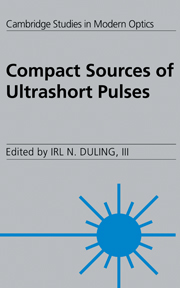Book contents
- Frontmatter
- Contents
- List of contributors
- Acronyms and abbreviations
- Preface
- 1 Short pulse generation
- 2 Passive modelocking in solid state lasers
- 3 Compact modelocked solid state lasers pumped by laser diodes
- 4 Modelocking of all-fiber lasers
- 5 Nonlinear polarization evolution in passively modelocked fiber lasers
- 6 Ultrafast vertical cavity semiconductor lasers
- 7 High power ultrafast semiconductor injection diode lasers
- 8 The hybrid soliton pulse source
- 9 Monolithic colliding pulse modelocked diode lasers
- Index
5 - Nonlinear polarization evolution in passively modelocked fiber lasers
Published online by Cambridge University Press: 20 January 2010
- Frontmatter
- Contents
- List of contributors
- Acronyms and abbreviations
- Preface
- 1 Short pulse generation
- 2 Passive modelocking in solid state lasers
- 3 Compact modelocked solid state lasers pumped by laser diodes
- 4 Modelocking of all-fiber lasers
- 5 Nonlinear polarization evolution in passively modelocked fiber lasers
- 6 Ultrafast vertical cavity semiconductor lasers
- 7 High power ultrafast semiconductor injection diode lasers
- 8 The hybrid soliton pulse source
- 9 Monolithic colliding pulse modelocked diode lasers
- Index
Summary
Introduction
Single-mode fibers typically contain two eigenmodes with the same light intensity distribution, but with orthogonal polarization states. In perfectly isotropic fibers these modes are degenerate and have the same propagation constants. Hence isotropic fibers are polarization maintaining, i.e. the output polarization state is the same as the input polarization state. However, this statement is not generally valid in the presence of nonlinearities. Though an isotropic fiber is still polarization maintaining for linearly and circularly polarized light independent of the light intensity, an elliptical polarization state will rotate as a function of power.
The phenomenon of ellipse rotation was already well known in the 1960s and was commonly used to measure the refractive index of isotropic materials with Kerr-type nonlinearities (Maker and Terhune, 1965). By incorporating suitable polarization optics, ellipse rotation can also be used as an ultrafast saturable absorber for passive modelocking, as first realized by Dahlström (1972). However in this work stable CW modelocking was not obtained due to the low available power levels. The first application of nonlinear polarization evolution in optical fibers dates back to Stolen et al. (1982), who used a highly-birefringent fiber for shortening and cleaning the pulses from a separate external ultra-short pulse source. Nonlinear polarization evolution for the general case of low birefringence fibers was first analyzed by Winful (1985), who also predicted the phenomenon of polarization instability when high intensity light is launched close to the fast axis of the fiber.
- Type
- Chapter
- Information
- Compact Sources of Ultrashort Pulses , pp. 179 - 207Publisher: Cambridge University PressPrint publication year: 1995
- 1
- Cited by



